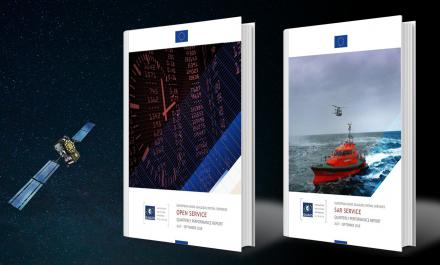OS and SAR Service Performance Reports of the third quarter of 2018 (covering July, August and September) have been published under the European GNSS Service Centre web portal, under Performance Reports section.
The third Galileo Open Service (OS) and SAR Service Quarterly  Performance Reports of 2018 are available on the Electronic Library, under the Performance Reports section, providing the status of the Galileo constellation and the achieved performance over the reported period (July, August and September 2018).
Performance Reports of 2018 are available on the Electronic Library, under the Performance Reports section, providing the status of the Galileo constellation and the achieved performance over the reported period (July, August and September 2018).
These quarterly reports provide the public with the latest information on the Galileo OS and SAR/Galileo Initial Services measured performance statistics with respect to their Minimum Performance Levels (MPLs), as declared in their respective Galileo Service Definition Documents (OS - SDD and SAR - SDD), in particular on parameters such as:
-
For Open Service: initial ranging performance, Galileo to GPS Time Offset (GGTO) determination performance, Galileo positioning performance and the Timely publication of NAGUs.
-
For SAR Service: detection and location performance, and infrastructure availability performance.
Highlights from Q3 2018 on Galileo OS and SAR Service:
As in previous periods, measured Galileo OS and SAR Service performance figures comfortably exceed their MPL thresholds.
Some highlights from the Q3 2018 performance reports:
-
The Availability of both the Galileo Ranging Service at the Worst User Location (WUL) and the Healthy Signal have been significantly better than the MPLs (all above the threshold of 87%), reaching the first figure on the reported quarter a monthly value of 100%.
-
The Galileo UTC Determination Service Availability has reached a constant monthly value of 100%. Moreover, the GGTO Determination Availability comfortably exceeds the MPL target of 87% over the reported month: 98.58% in July and August and 98.84% in September.
-
The target MPLs for Publishing NAGUs were met for both Planned and Unplanned events. A total number of 9 NAGUs have been published on the GSC web portal in the reported period, neither of them announcing unplanned events.
-
Detection Service Probability for each of the Reference Beacons (REFBE) every month was above the MPL (which is 99%).
-
Both the single and multi-burst Location Probabilities for each REFBE were, in all cases, well above the MPLs (which are 75% and 98%, respectively).
-
SAR/Galileo Service Infrastructure Performance is measured by the availability of the Ground Segment, Space Segment and SAR Server. As a particular case of the Ground Segment availability, the MEOLUTs have reached better values than the MPL target (95%) in "Nominal" mode during the whole period: average availability of 96.9% for Larnaca and Spitsbergen and 98.1% for Maspalomas.
For the most up-to-date information on the Galileo system and constellation, visit the European GNSS Service Centre (GSC) website, in particular, the Galileo constellation status section. For an exhaustive description of the Minimum Performance Levels (MPLs), refer to the Galileo OS SDD.
For more details on Galileo performance and its Services, do not hesitate to contact the Galileo Help Desk.
Help us on shaping the future of Galileo! Just a few minutes of your time are needed to complete the Galileo User Satisfaction Survey 2018.
Media note: This feature can be republished without charge provided the European GNSS Agency (GSA) is acknowledged as the source at the top or the bottom of the story. You must request permission before you use any of the photographs on the site. If you republish, we would be grateful if you could link back to the GSA website (http://www.gsa.europa.eu).